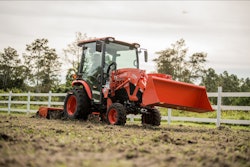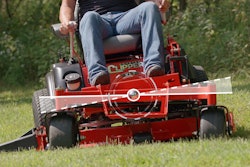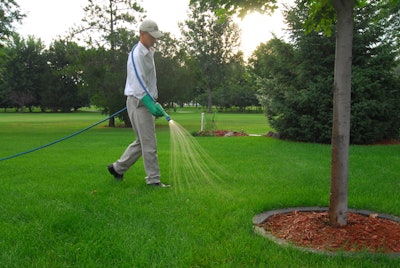

Most pre-emergence herbicides are designed to control annual grassy weeds such as crabgrass, goosegrass, foxtail and annual bluegrass. They can also be used to control certain annual broadleaf weeds such as chickweed, knotweed and spurge, says Matt Giese, technical services manager for Syngenta.
Barricade is one of the herbicides that can treat both annual grasses and annual broadleaf weeds.
He stresses that due to the differences in weed species controlled by pre-emergence herbicides, it’s important to reference specimen labels and accurately identify target weed species.
“Proper weed control starts with identification and knowing the life cycle and key biological aspects of the target weed,” says Yusif Jaouni, a Corteva Agriscience Turf & Ornamental territory manager. “This will help you pick the right product, as well as key timing of when to apply.”
Below are some of the ways to combat the common reasons pre-emergence herbicides fail to control weeds and ensure your pre-emergence applications are as effective as possible.
Perfect timing
“Applying too late for the target weed is usually the primary reason pre-emergence herbicides fail,” says Zac Reicher, Ph.D., Bayer Green Solutions Team specialist.
Because different weeds have varying life cycles and germinate at different times, it’s important to know which weeds you are targeting in order to properly apply the herbicide at the right time.
“Depending on the target weed species, a single spring application may or may not be effective for subsequent germinating weeds,” Giese says. “For example, knotweed is estimated to germinate with soil temperatures ranging from 35-50°F, while crabgrass typically germinates around 55°F soil temperatures. A properly timed application for crabgrass in this scenario would be too late for control of knotweed.”
As the name implies, pre-emergence herbicides should be applied prior to the emergence of the target weed. Pre-emergence herbicides drastically lose their effectiveness once weeds are established, as they are formulated to inhibit root growth.
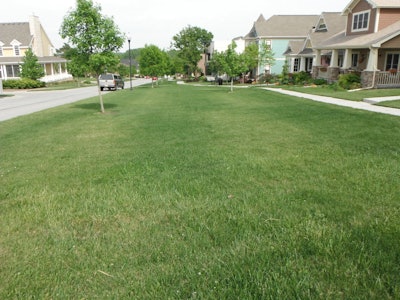 Poor application pattern from pre-emergence herbicide/fertilizer combinations will lead to weed control failures later in the summer.Bayer
Poor application pattern from pre-emergence herbicide/fertilizer combinations will lead to weed control failures later in the summer.Bayer
“Timing’s extremely important of when those go down,” says Chris Lemcke, technical director for Weed Man. “And the reason that’s important is because they start to biodegrade and start to lose effectiveness as soon as they go out into the soil, and microbes will start breaking them down.”
One herbicide that is a little more forgiving on the timing is Dimension, which provides both pre- and post-emergence control of crabgrass.
“This provides a wider and more flexible application window to control crabgrass,” Jaouni says. “For control of winter annuals, pre-emergence applications should be made in early fall, while for summer annuals, applications should be made in the spring prior to germination to maximize control.”
Calibrate correctly
Another major factor that can cause a pre-emergence herbicide to not provide effective weed control is if the lawn care operator has failed to calibrate their equipment properly.
“Uniform distribution is critical for maximum control since pre-emergence herbicides do not move much in the soil,” Reicher says. “Choose spreadable products with smaller granules and ensure accurate and complete coverage with lawn guns or hand sprayers.”
Over-calibrating can result in wasting both product and money, while under-calibrating can cause compromised weed control, customer callbacks and even the loss of clients.
“If you don’t calibrate, you’re foolish,” Lemcke says. “You have to calibrate. In our business, if we find someone not calibrating, we say ‘Why run your business?’ If you can’t do this, this is one of the simplest things you can do in your business, you might as well not even operate the business. Calibration is one of the most important things you can do as an operator because that’s going to tell you whether you’re spending too much money or you’re not putting enough product down.”
Lemcke adds that calibrating can take only five minutes and even when an operator is over by 10 percent, it can quickly add up to $2,000 out of your pocket over the course of the season.
“The specimen label for a given product will provide the best recommendations for use and application guidelines for best results,” Giese says.
Water in applications
Pre-emergence herbicides can also fail to control weeds when they are not “activated” or watered in after application or shortly afterward.
“Yellow-staining herbicides, for example (prodiamine, pendimethalin, trifluralin, etc.), all experience reduced efficacy due to their breakdown in sunlight if the product is not watered in within the recommended time period after application,” Jaouni says.
Lemcke says a pre-emergence herbicide typically needs to be watered in within 48 hours to 10 days to give it the best chance of working in the soil.
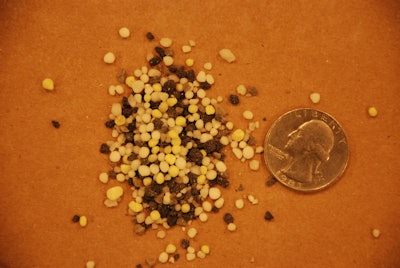 Herbicide/fertilizer combinations can vary widely in granular size, so calibration and application accuracy is critical.Bayer
Herbicide/fertilizer combinations can vary widely in granular size, so calibration and application accuracy is critical.Bayer
However, with Specticle, operators can wait up to 28 days after application to water in the product.
Post-emergence applications
Another best practice is to know when to make use of post-emergence herbicides as there are some weeds that are better treated with this control method.
“Unlike weeds with an annual life cycle, perennial weeds typically do not regenerate from seed each spring and therefore cannot be controlled with pre-emergence herbicides,” Giese says. “Post-emergence herbicides are more effective for targeting weeds with perennial life cycles that begin in the spring as established plants and are effectively controlled before full maturity is reached. Examples might include broadleaf plantain and dandelion.”
Perennial sedges like yellow and purple nutsedge, doveweed and ground ivy are other types of weeds that require a post-emergence herbicide.
“Generally, if the weed is already visible above the soil surface, a post-emergence herbicide should be used for controlling those weeds,” Jaouni says. “By definition, most pre-emergence herbicides on the market will not provide control if the weed is already emerged.”
Lemcke says they typically wait until the fall to do most of their lawn seedings to avoid issues with pre-emergence herbicides inhibiting turf growth. He says while there are pre-emergence products that allow you to treat properties and overseed at the same time, such as Tenacity, they prefer to avoid using pre-emergence herbicides on the lawns that need seeding and use post-emergence to control weeds like crabgrass.
Other tips for pre-emergence herbicides
Lemcke suggests splitting applications with one early in the spring and another a little bit later on for a longer-lasting application.
“What you’re doing is you’ve given a certain amount of an active ingredient early on to prevent any early germination,” Lemcke says. “Then you do a second application a little bit later to inoculate the soil and put another barrier down, as what is already there may have already started breaking down.”
Giese advises scouting for weeds present during the previous season. When working on a new property, pay attention to the weeds on adjacent properties and build a program that follows the manufacturer’s recommendations.
“Knowing what weed species are present on a property will be critical in developing a successful management plan,” Giese says. “To help you target each species, you can sign up for pest alerts at GreenCastOnline.com/AgronomicAlerts that will notify you when it’s the best time to make applications based on your location. You can choose from several different weed alerts and have updates delivered to your inbox during the best window for application. Other alert options include tracking of growing degree days and various other pests that infest turfgrass.”
Jaouni says that in the end, it really comes down to getting the basics right, including the timing, rate, coverage and irrigation requirements.
“The industry offers many classes and training to help improve application and product selection,” Jaouni says. “We encourage landscapers to reach out to their herbicide experts such as their local Corteva territory manager and/or chemical distributor who can offer many tips and tricks to improve their weed performance and operation.”


